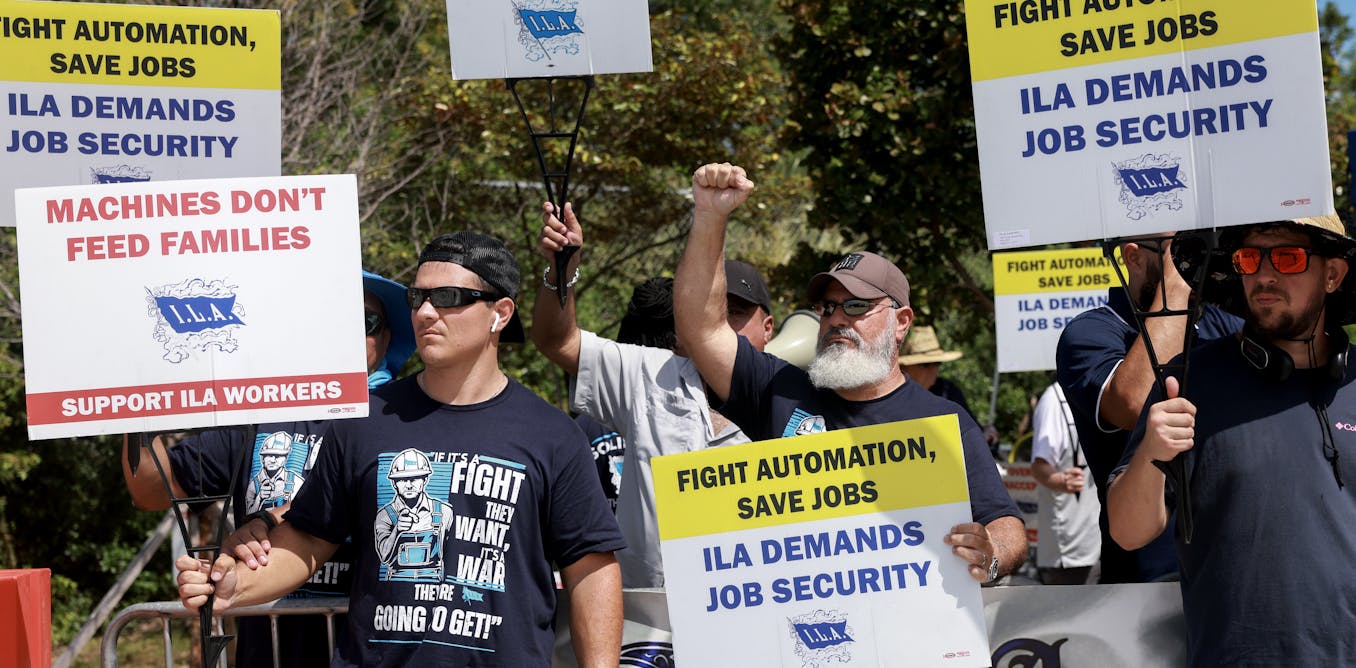A dockworkers strike that froze operations at East Coast and Gulf Coast ports for 2½ days was paused on Oct. 3. The Conversation U.S. asked Anna Nagurney, a scholar of supply chains, to assess the extent of disruptions that likely occurred and how the swift return of 45,000 workers who had been on strike may stave off further problems down the road.
Why was the strike suspended?
Aided by intense pressure from senior Biden administration officials, the shipping companies, represented by the U.S. Maritime Alliance, significantly increased the raise they were offering the dockworkers to 62% from their previous offer of a 50% boost in pay. The International Longshoremen’s Association, the dockworkers’ union, were seeking a 77% raise, but it accepted the new offer, which will be phased in over six years.
The agreement labor leaders and management reached will suspend the strike until at least Jan. 15, 2025, allowing more time for additional collective bargaining and negotiations.
Talks over other contested conditions, including the adoption of more automation, will continue until then.
President Joe Biden applauded both sides. He thanked the union and management “for acting patriotically to reopen our ports and ensure the availability of critical supplies for Hurricane Helene recovery and rebuilding.”
How has this strike affected the economy?
About half of the products that the U.S. imports are handled by the ports that were paralyzed during this brief strike. About 1 million shipping containers arrive at these ports every month.
Imports include vast quantities of bananas and other fresh produce, coffee, pharmaceuticals, liquor, toys, apparel, furniture, machinery and vehicles. Exports include meats, commodities, machinery, chemicals, vehicles and vehicle parts.
The strike’s impact was immediate. More than 50 ships laden with hundreds of thousands of containers created a logjam at East Coast ports. Major retailers, such as Walmart, Costco, Lowes and Home Depot, were among the companies stuck waiting for the release of their stranded cargo.
It may take two to three weeks to relieve this logjam. Prices for some products, including coffee, were already rising before the negotiators reached their breakthrough.
Workers are critical to the functioning of each link in supply chains. When the dockworkers were on strike, other workers, such as truckers, rail employees and warehouse workers, were concerned about being affected, as well as all the businesses that rely on them, such as restaurants.
Spencer Platt/Getty Images
Why is the new time frame significant?
Shipping tied to the holiday season typically runs from July through early November. Members of the National Retail Federation, the largest U.S. retail trade group, have already been dealing with significant supply disruptions due to Houthi attacks in the Red Sea and Suez Canal. The attacks have forced shipping companies to take longer routes, delaying cargo delivery and increasing costs due to the need for more fuel and labor.
A prolonged dockworkers strike would put stress on the economy. According to J.P. Morgan, a lengthy dockworkers strike could have cost the U.S. economy US$5 billion per day.
The temporary agreement pushes the strike past the U.S. elections in November and the conclusion of the upcoming holiday season. That gives both sides a chance to return to the bargaining table to continue to negotiate and to reach an agreement on the issues that haven’t been resolved yet – notably the use of automation.
Having a shorter strike will reduce the risk of shortages of everything from mangos to Maseratis and the price increases that typically occur when products are scarce and in high demand.

Shannon Finney/Getty Images for Care Can’t Wait Action
What did the Biden administration do?
The Biden administration was eager for a settlement, especially with the ports serving as channels for recovery supplies after the massive damage seen in Florida, western North Carolina and other areas near the East Coast from Hurricane Helene.
Senior government officials made notable progress when they met with representatives of shipping companies before daybreak on Oct. 3 over Zoom.
Julie Su, the acting labor secretary, had been working hard to help the two sides settle their differences. She emphasized over Zoom that she could get the International Longshoremen’s Association to the bargaining table to extend the contract. Transportation Secretary Pete Buttigieg also stayed in touch with labor and management, and used that Zoom meeting to tell the shipping companies that they would need to offer the dockworkers a higher wage.
White House Chief of Staff Jeff Zients told the shipping companies on Zoom that they should make an offer to the union quickly so that the strike wouldn’t further exacerbate the effects of Hurricane Helene.
It seems clear to me that the pressure worked – helped, perhaps, by a bit of patriotism.




